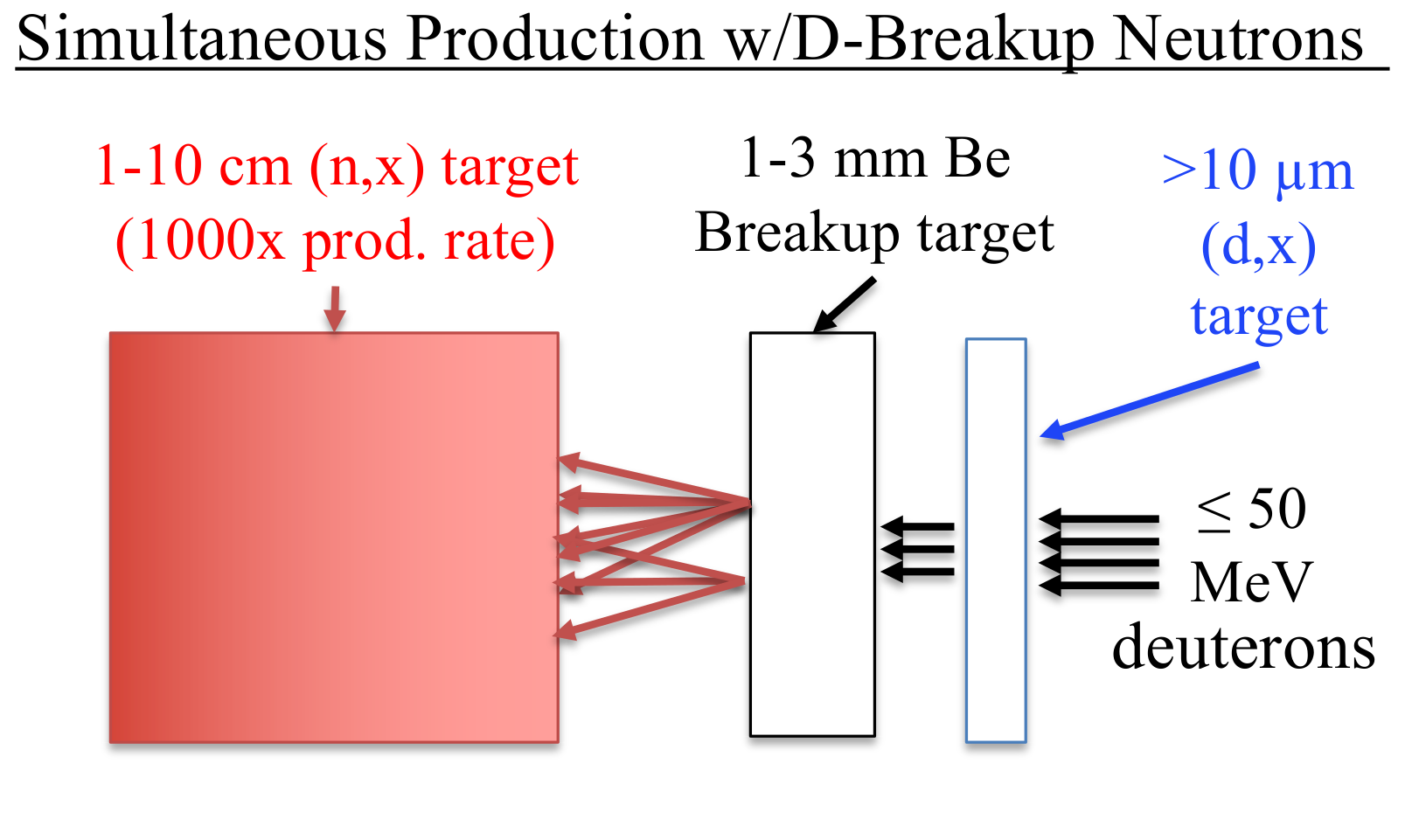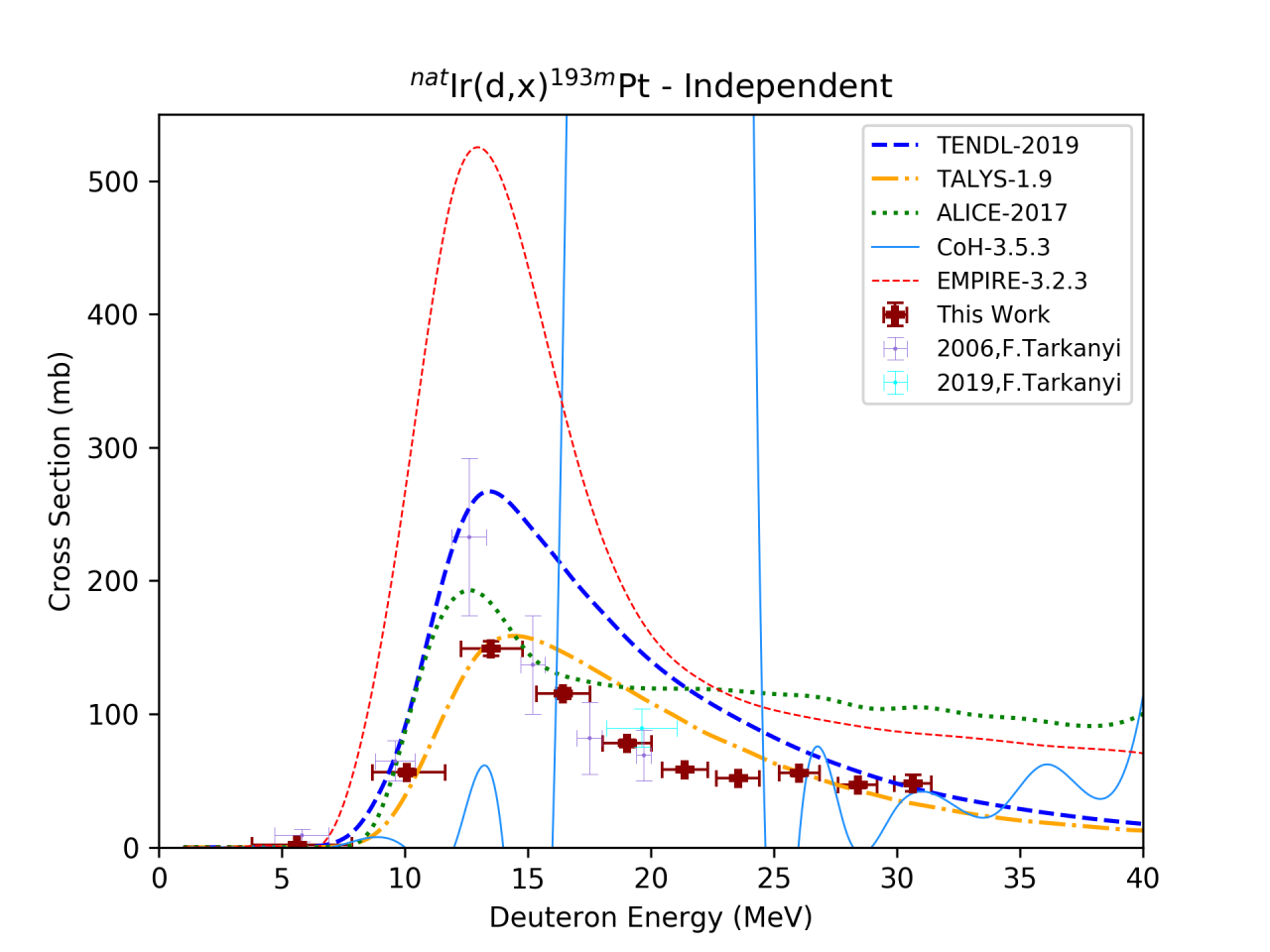The nuclear data program has explored the use of intense fast neutron beams from the breakup of energetic deuteron beams from the 88-Inch Cyclotron on Low-Z targets. The range of these fast neutrons is significantly higher than corresponding charged particle beams since they do not lose energy through electronic stopping. Work by Saltmarsh and Meulders indicates that as much 3-9% of a deuteron beam can be converted into a high-flux neutron beam via thick target deuteron breakup.
Consider for example the production of the promising targeted alpha-therapeutic radionuclide 225Ac. This radionuclide can be made “directly” via the reaction: 226Ra(p,2n)225Ac Or indirectly via the reaction 226Ra(n,2n)225Ra → 225Ac.
However, the direct production rate is limited by the energy loss of the proton beam in the radium sample. The ideal production rate using values from the TENDL nuclear data library would utilize a 30 MeV proton beam and a target with a thickness of approximately 1.6 g/cm2. This would yield a production rate of: R(p,2n)=I(ρR)1.6 g/cm2σ(p,2n) ≈ 7.4 x 109 atoms/µA*s
While production via neutron irradiation would allow the use of a target with a 5% breakup efficiency could utilize a target with a thickness several hundred times thicker! Even without considering the ability to “reflect” back elastically-scattered neutrons this could yield a production rate of: R(n,2n)=I(ρR)160 g/cm2σ(n,2n)(0.05) ≈ 1.9 x 1011 atoms/µA*s

Another advantage to using neutrons from deuteron breakup for isotope production is that the deuteron beam can be used to produce other radioisotopes simultaneously via (d,x) reactions. Our program has been measuring many of these (d,x) reactions for production of the imaging radionuclide 86Y and 193mPt.
The production rate depends on the neutron energy spectrum from breakup, which in turn depends on the incident deuteron energy, the breakup target material and the at which the target material is placed. Jon Morrell has been working to characterize the deuteron breakup spectrum through a series of measurements and the development of a new hybrid model.
Simultaneous Production Candidates: Cu/Zn, Ir(d,x)
The goal of this project is to determine the feasibility of simultaneous radionuclide production, where an energetic deuteron beam produces one candidate isotope via a (d,x) reaction on a thin target layer, and subsequently loses a small amount of energy via electronic stopping. The remaining unreacted deuteron beam is then made incident on a thicker low-Z target where a significant portion of it undergoes breakup, producing an intense, forward-focused neutron flux which is made incident on a thick (> g/cm2) target for the production of a second candidate isotope.
As an initial example of the feasibility of this approach, this project involved measuring production cross sections for a number of (d,x) reactions that could be combined with secondary neutron production. One of these is for the promising Auger therapeutic radionuclide 193mPt which can be produced via the Ir(d,x)193mPt reaction. Auger emitters such as 193mPt produce a cascade of 20-30 low-energy electrons, which deposit their energy over a range of several nm to um, comparable or smaller than the ˜6um size of most human cells. This short range makes Auger emitters potentially invaluable for cancer therapy, as the cascade of electrons is extremely lethal to targeted cancer cells, but can potentially spare surrounding healthy tissue.

193mPt (t1/2 = 4.33 d) is believed to have therapeutic potential when labelled to the chemotherapeutic drug cisplatin. Radionuclides produced from deuterons on natural iridium such as 191Pt, 193mPt, 192Ir and 194Ir have potential to be used in medicine, for example in chemotherapy, brachytherapy, radioimmunotherapy and imaging. Platinum radionuclides are of special interest. Platinum is the main element in the chemotherapeutic agent cisplatin, a drug which is clinically used in treatment of testicular and ovarian cancer. One of the major challenges with cisplatin is its chemical toxicity. However, when auger-emitters such as 193m Pt are substituted for stable platinum, the local auger-damage effect increases the chemical damage of cisplatin. The combination of cisplatin and auger-emitting nuclei suggests that a smaller amount of the drug is required, and the toxicity can be reduced.
One example of (n,x) production which can be paired with 193mPt to utilize the secondary neutrons from breakup of the unreacted deuteron beam is the production of 64Cu and 67Cu, from Zn(n,x). 64Cu (t1/2 = 12.701 h) is a potent PET isotope, and is desired for use as a novel imaging agent for diagnostic procedures. 67Cu (t1/2 = 61.83 h) emits several low-energy beta particles, making it potentially useful for brachytherapy and treatment of other large tumors. However, 67Cu currently has extremely limited options for production, as it cannot be produced using conventional charged particle - based pathways. The use of fast neutrons from deuteron breakup presents a unique approach for production of this radionuclide, as well as others inaccessible through accelerator-based irradiations. Notably, using the breakup neutron spectrum for Zn(n,x), 64Cu and 67Cu are produced in a ratio which is tunable via the deuteron beam energy. As these two radionuclides form a "theranostic pair", where chemically similar isotopes may be simultaneously administered for a combination of therapy and real-time imaging, this production pathway presents an interesting opportunity to study the potential benefit of this new toolkit in the diagnosis and treatment of disease.